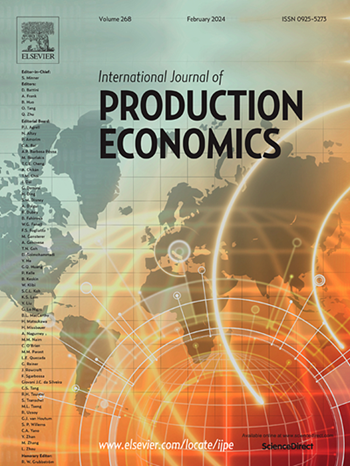循环供应链网络设计:一种鲁棒概率多目标优化方法
IF 10
1区 工程技术
Q1 ENGINEERING, INDUSTRIAL
引用次数: 0
摘要
循环供应链(CSCs)对于推进循环经济(CE)至关重要,循环经济旨在通过可再生的自然系统最大限度地减少浪费和最大化资源再利用。CSCs将第一产业的参与者与回收、二次材料和能源部门的参与者联系起来。然而,向有效的CSCs过渡需要系统性的转变,强调跨部门合作,并在不确定的环境中平衡经济、环境和社会目标。因此,本研究提出了一个三目标多扇区CSC网络设计模型,将其表述为一个混合整数线性规划问题,并使用ϵ-constraint方法求解。为了解决CE环境中的模糊和随机不确定性,采用鲁棒模糊随机规划(RFSP)方法对需求和回收率、再制造、回收、再循环率和生产成本等不确定参数进行集成。对关键参数的敏感性分析,如废物系数和初级和次级产品的价格,进一步评估了网络对循环过渡的准备情况。通过对法国轮胎行业的案例研究证明了该模型的实际相关性,该案例揭示了循环系统中复杂的相互依赖性,并为法国一级和二级市场的利益相关者提供了有价值的见解。研究结果强调了这些行业在循环转型中的相互关联作用,并强调了将不确定性纳入CSC设计以有效平衡竞争目标的重要性。本研究为学术文献提供了强有力的方法,并为政策制定者和行业领导者提供了追求全面可持续性和资源循环的战略决策的关键见解。本文章由计算机程序翻译,如有差异,请以英文原文为准。
Circular supply chain network design: A robust probabilistic multi-objective optimisation approach
Circular supply chains (CSCs) are essential to advancing the circular economy (CE), which aims to minimise waste and maximise resource reuse through regenerative natural systems. CSCs connect actors in primary industries with those in the recycling, secondary materials, and energy sectors. However, the transition to effective CSCs requires a systemic shift that emphasises cross-sectoral collaboration and balances economic, environmental, and social objectives in an uncertain environment. Therefore, this study proposes a tri-objective multi-sector CSC network design model, formulated as a mixed-integer linear programming problem and solved using the -constraint method. To address both fuzzy and stochastic uncertainties in the CE context, a robust-fuzzy stochastic programming (RFSP) approach is used to integrate uncertain parameters such as demand and return rates, remanufacturing, recovery, recycling rates, and production costs. A sensitivity analysis of critical parameters, such as waste coefficients and the prices of primary and secondary products, further assesses the readiness of the network for a circular transition. The practical relevance of the model is demonstrated through a case study of the French tyre industry, which reveals complex interdependencies in the circular system and provides valuable insights for stakeholders in the French primary and secondary markets. The findings highlight the interrelated roles of these industries in circular transitions and underline the importance of integrating uncertainty into the design of CSC to effectively balance competing objectives. This study contributes to the academic literature by applying a robust methodological approach and provides policymakers and industry leaders with key insights for strategic decision-making in pursuit of comprehensive sustainability and resource circularity.
求助全文
通过发布文献求助,成功后即可免费获取论文全文。
去求助
来源期刊
CiteScore
21.40
自引率
7.50%
发文量
266
审稿时长
52 days
期刊介绍:
The International Journal of Production Economics focuses on the interface between engineering and management. It covers all aspects of manufacturing and process industries, as well as production in general. The journal is interdisciplinary, considering activities throughout the product life cycle and material flow cycle. It aims to disseminate knowledge for improving industrial practice and strengthening the theoretical base for decision making. The journal serves as a forum for exchanging ideas and presenting new developments in theory and application, combining academic standards with practical value for industrial applications.

 求助内容:
求助内容: 应助结果提醒方式:
应助结果提醒方式:


